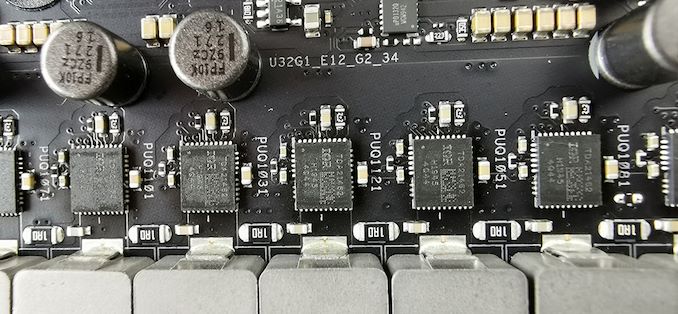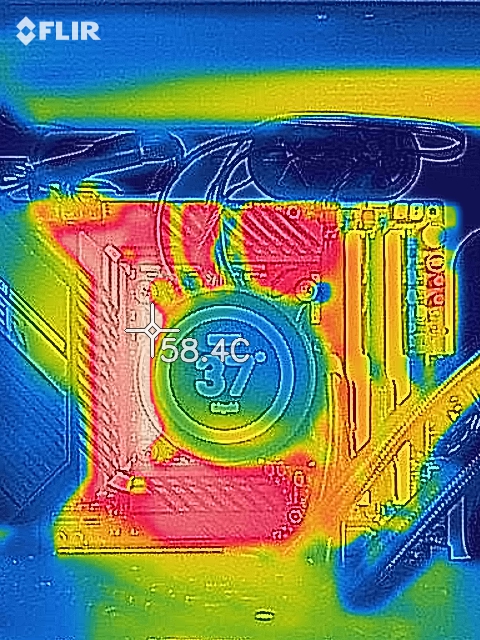ASUS ROG Maximus XII Hero Wi-Fi Review: The Tale of Two Motherboards
by Dr. Ian Cutress & Gavin Bonshor on June 11, 2020 11:45 AM EST- Posted in
- Motherboards
- Intel
- Asus
- ROG
- 5GBase-T
- Z490
- 10th Gen Core
- Comet Lake
Power Delivery Thermal Analysis
A lot more focus has been put onto power delivery specifications and capabilities, not just by manufacturers, but as a result of users demands. In addition to the extra power benefits from things like overclocking, more efficient designs in power deliveries and cooling solutions aim to bring temperatures down. Although this isn't something most users ever need to worry about, certain enthusiasts are bringing more focus onto each boards power delivery. The more premium models tend to include bigger and higher-grade power deliveries, with bigger and more intricate heatsink designs, with some even providing water blocks on ranges such as the ASUS ROG Maximus Formula series.

The ROG Maximus XII Hero WiFi uses a 16-phase design in 7+1 mode, with TDA21490 90 A Power stages
Testing Methodology
Our method of testing out if the power delivery and its heatsink are effective at dissipating heat, is by running an intensely heavy CPU workload for a prolonged method of time. We apply an overclock which is deemed safe and at the maximum that the silicon on our testbed processor allows. We then run the Prime95 with AVX2 enabled under a torture test for an hour at the maximum stable overclock we can which puts insane pressure on the processor. We collect our data via three different methods which include the following:
- Taking a thermal image from a birds-eye view after an hour with a Flir Pro thermal imaging camera
- Securing two probes on to the rear of the PCB, right underneath CPU VCore section of the power delivery for better parity in case a probe reports a faulty reading
- Taking a reading of the VRM temperature from the sensor reading within the HWInfo monitoring application
The reason for using three different methods is that some sensors can read inaccurate temperatures, which can give very erratic results for users looking to gauge whether an overclock is too much pressure for the power delivery handle. With using a probe on the rear, it can also show the efficiency of the power stages and heatsinks as a wide margin between the probe and sensor temperature can show that the heatsink is dissipating heat and that the design is working, or that the internal sensor is massively wrong. To ensure our probe was accurate before testing, I binned 10 and selected the most accurate (within 1c of the actual temperature) for better parity in our testing.
To recreate a real-world testing scenario, the system is built into a conventional desktop chassis which is widely available. This is to show and alleviate issues when testing on open testbeds which we have done previously, which allows natural airflow to flow over the power delivery heatsinks. It provides a better comparison for the end-user and allows us to mitigate issues where heatsinks have been designed with airflow in mind, and those that have not. The idea of a heatsink is to allow effective dissipation of heat and not act as an insulator, with much more focus from consumers over the last couple of years on power delivery componentry and performance than in previous years.

ASUS ROG Maximus XII Hero WiFi undergoing our VRM thermal testing (We test with the side panel on)
For thermal image, we use a Flir One camera as it gives a good indication of where the heat is generated around the socket area, as some designs use different configurations and an evenly spread power delivery with good components will usually generate less heat. Manufacturers who use inefficient heatsinks and cheap out on power delivery components should run hotter than those who have invested. Of course, a $700 flagship motherboard is likely to outperform a cheaper $100 model under the same testing conditions, but it is still worth testing to see which vendors are doing things correctly.
Thermal Analysis Results

We measured 58.4°C on the hottest part of the PCB around the CPU socket and power delivery
The ASUS ROG Maximus XII Hero WiFi is equipped with a 16-phase power delivery with fourteen Infineon TDA21490 90 A power stages for the CPU, and two TDA21490 90 A power stages for the SoC. The power delivery is controlled by an ASP1405I 8-phase controller operating at 7+1, as ASUS is using teamed power stages for better efficiency, more consistent power throughput, and improved transient response. The Maximus XII Hero WiFi is using three heatsinks to cool the power delivery which is all interconnected via a nickel-plated copper heat pipe, with deep grooves in the aluminium fins designed to channel passive airflow.
Focusing on the thermal performance, the ASUS ROG Maximus XII Hero WiFi power delivery operates well within the guideline specifications of each part when subjected to our test method. We measured 58°C from the integrated VRM thermal sensor on the board, with a matching reading of 58°C from our first thermal probe. We saw a bit of variance compared to our second probe which we measured at 52°C, although we did pick up another consistent reading of 58.4°C from our FLIR thermal imaging camera.
Compared to the other models on test, it leaves us no doubt that the ROG Maximus XII Hero WiFi has plenty to offer for overclocks, with lots of potential headroom left. The ASRock model is running cooler due to its active cooled power delivery heatsink, but the GIGABYTE currently wins out in our power delivery thermal testing with its design.











29 Comments
View All Comments
Dug - Thursday, June 11, 2020 - link
I wonder how the USB, 5Gb ethernet, m.2 slots, sound with DAC, and wi-fi test out, sense it's not tested here.Alistair - Thursday, June 11, 2020 - link
This is the same problem I had with the 10700k. 5.1ghz and I'm not much faster than stock settings, but making more heat. 5.2ghz and I hit thermal throttle but am stable. That's with a VERY expensive cooler, the Kraken.eastcoast_pete - Thursday, June 11, 2020 - link
Thanks! Question @ Ian or Gavin: Any statement from Intel how going with the MB's performance setting affects Intel's warranty? In other words, if I would have an Intel CPU in one of these and the CPU goes belly up, would Intel assume that I ran it outside their recommendations and decline to cover it under warranty? Thanks!Alexandrus - Thursday, June 11, 2020 - link
I clearly see the PowerStages marked as TDA21462, which is a 60A part, yet the article insists on them being the TDA21490, which is a 90A part.There is no confusion here, come on, they are very different, by exactly 50%.
NorySS - Friday, June 12, 2020 - link
This article has errors about the vrm. You list and mention multiple times that the board uses TDA21490 90 A power stages, yet in the picture of the power stages, it is a TDA21462 part number. Which when Google is a 60Amp power stage.Tenujonny - Tuesday, June 23, 2020 - link
All things considered, you can have it even consistently as a principle wellspring of cancer prevention agents and you will be astonished to know a reality, it helps in battling gloom as well. In this way, you can put it all on the line. Be that as it may, the Bilberry Supplements are somewhat exorbitant so you may be in two personalities. Stress not! There are such huge numbers of coupon codes accessible, for example, "BERRY60" or "BIL70", and numerous others. In this way, you will get an enormous markdown while getting them disconnected and online both. https://gomommacoupons.com/billberry-extract-capsu...Geethagovitha - Friday, June 26, 2020 - link
Before you put your tangle inside the clothes washer, ensure the to dispose of bunching dirt, precious stone, pine particles. It very well may be finished by just shaking the tangle. You can guarantee that by balancing the tangle outside for some time. From that point onward, drop a little measure of low focus cleanser into the machine and put the tangle inside. <a href="https://matscorner.com/">Mats Corner</a>AnnaSmith - Tuesday, June 30, 2020 - link
Glad to see this post, great stuff. https://printingproslittlerock.comcopperluke1 - Friday, July 3, 2020 - link
안녕, 잘 했어 기사의 내용을 관리하는 방식과 웹 사이트의 모양과 느낌을 이해해야합니다. 당신은 정말로 위대한 일을하고 있습니다. https://ct.visastates.com/Tenujonny - Monday, July 6, 2020 - link
Residence SP Setia is incredibly very much associated with the remainder of Singapore. Getting back and forth is a breeze with significant interstates and streets with any semblance of Pan Island Expressway(PIE), Bukit Timah Expressway(BKE) and Bukit Timah Road. As the separation to the two freeways passageways are amazingly close, in an insignificant 20 minutes drivers can get to Orchard Shopping Belt by means of PIE leaving Stevens Road, the Central Business District(CDB)/Marina Bay territory by means of Ayer Rajah Expressway(AYE) leaving Marina South Keppel Road and Holland region through Dunearn Road and Farrer Road. https://www.theavenuesouthresidences.com/